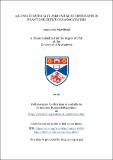Files in this item
α,β-Unsaturated acyl ammonium intermediates in enantioselective organocatalysis
Item metadata
| dc.contributor.advisor | Smith, Andrew David | |
| dc.contributor.author | Matviitsuk, Anastassia | |
| dc.coverage.spatial | xvi, 321 p. | en_US |
| dc.date.accessioned | 2019-10-15T08:27:42Z | |
| dc.date.available | 2019-10-15T08:27:42Z | |
| dc.date.issued | 2019-06-26 | |
| dc.identifier.uri | https://hdl.handle.net/10023/18667 | |
| dc.description.abstract | The research outlined in this thesis focuses on the study of the reactivity of α,β-unsaturated acyl ammonium intermediates and their utility in the development of new enantioselective processes exploiting isothiourea organocatalysts. Chapter 2: A novel isothiourea-catalysed domino process has been developed demonstrating the synthetic power of α,β-unsaturated acyl ammonium intermediates to generate a library of complex heterocyclic compounds. The use of these intermediates, generated in situ from trichlorophenol-activated ester and HyperBTM, proved successful in the development of an asymmetric Michael-Michaellactonisation reaction with 1,3-dicarbonyls. This method gives a quick and simple approach to a wide range of highly functionalised lactones (20 examples) bearing three contiguous stereocentres in moderate to good yields (46-79%). Excellent diastereo- and enantioselectivities (up to >95:5 dr, up to >99:1 er) were obtained due to the catalyst controlled nucleophilic addition. Resulting indane derivatives represent potential biologically and pharmaceutically relevant molecules. Chapter 3: The scope of the new domino reaction was extended employing benzazoles as an alternative pro-nucleophile class. Utilising acyl benzothiazoles selective N-cyclisation was observed through the operation of a domino Michael-lactamisation-Michael reaction, whilst the use of acyl benzimidazoles gave an alternative domino reaction pathway and selective access to quaternary stereocentres. The stereodivergence of these domino processes was studied by varying the electronic properties of the benzothiazole nucleophiles. A broad scope of complex fused polycycles (26 examples) was synthesised using this methodology with good to excellent yields (up to 94%) and high levels of stereocontrol (up to >95:5 dr; up to 97:3 er). Chapter 4: A new general concept for α-unsaturated acyl ammonium catalysis has been developed which exploits 4-nitrophenoxide release from an α,β-unsaturated 4-nitrophenyl ester substrate to facilitate catalyst turnover. This method was used for the enantioselective isothioureacatalysed Michael addition of nitroalkanes to α,β-unsaturated 4-nitrophenyl esters (27 examples, up to 79% yield, 99:1 er). The synthetic utility of this methodology was demonstrated through a simple synthesis of highly enantioenriched pyrrolidinones. Mechanistic investigations including kinetic analysis, catalyst labelling and crossover studies have delivered a fundamental understanding of this process, with the application of a recently reported variable time normalisation graphical analysis method used to allow the complex reaction kinetics to be probed. Chapter 5: Alternative catalyst turnover within α,β-unsaturated acyl ammonium catalysis was further explored. A novel approach to highly enantioenriched y-nitro esters was developed, which exploits the use of silyl nitronates to both undergo enantioselective Michael addition and facilitate catalyst turnover, through a silyl migration/[3,3]-rearrangement pathway, unprecedented in enantioselective catalysis. Application of silyl nitronates, as more active surrogates than their parent nucleophiles nitroalkanes, allows their use as stoichiometric reagents with a wide range of resulting y-nitro-substituted silyl esters (25 examples) obtained with good to excellent diastereoand enantioselectivity (up to >95:5 dr, up to >99:1 er). | |
| dc.language.iso | en | en_US |
| dc.publisher | University of St Andrews | |
| dc.subject.lcc | QD505.M288 | |
| dc.title | α,β-Unsaturated acyl ammonium intermediates in enantioselective organocatalysis | en_US |
| dc.type | Thesis | en_US |
| dc.contributor.sponsor | Engineering and Physical Sciences Research Council (EPSRC) | en_US |
| dc.type.qualificationlevel | Doctoral | en_US |
| dc.type.qualificationname | PhD Doctor of Philosophy | en_US |
| dc.publisher.institution | The University of St Andrews | en_US |
| dc.identifier.doi | https://doi.org/10.17630/10023-18667 |
This item appears in the following Collection(s)
Items in the St Andrews Research Repository are protected by copyright, with all rights reserved, unless otherwise indicated.

